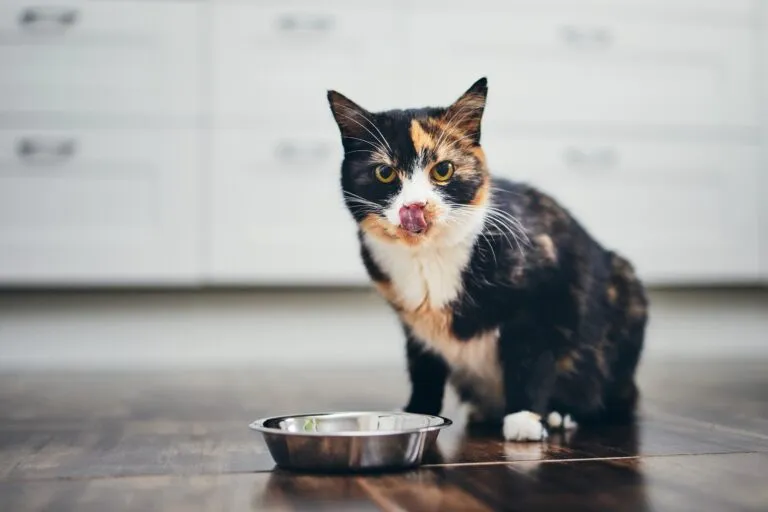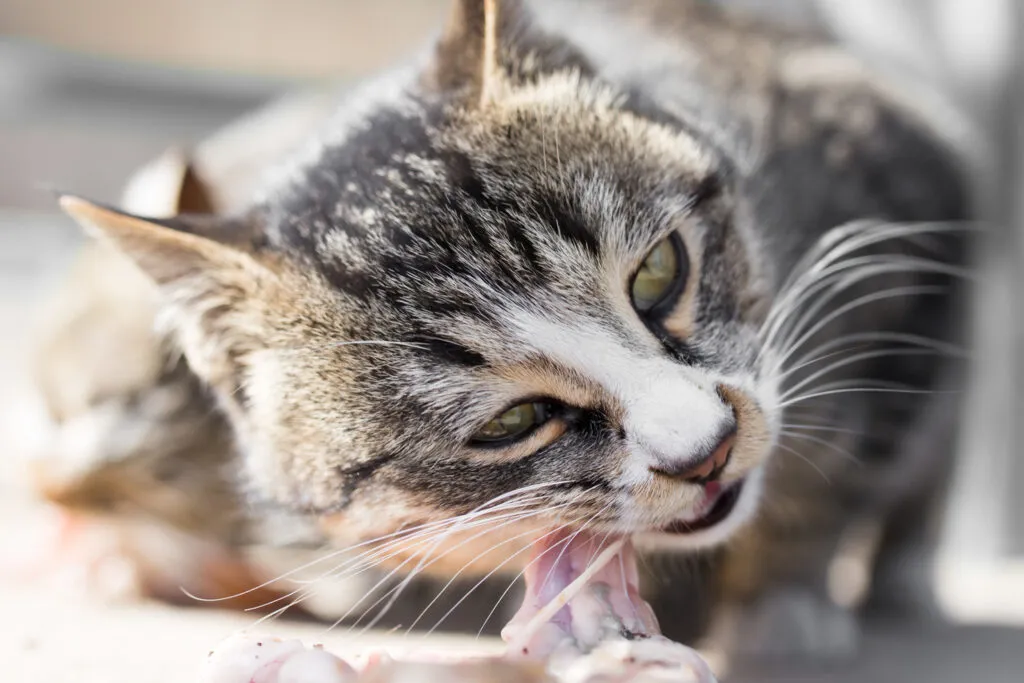How to Determine the Right Amount of Food for Your Cat
Some cats always seem to be hungry. But how much food does a cat need per day? This article helps you to find out the right amount of food for your cat.
"You are what you eat" – this principle applies to our feline friends too. But how do you recognise good food for your cat? What nutrients do our domestic lions need? And is there such a thing as the perfect cat food?

© Chalabala / stock.adobe.com
A young cat needs nutrients to grow, and an adult cat needs them to thrive. Without the right building blocks, their body can’t maintain balance
The search for the right cat food can seem complicated, especially if you browse through internet forums or sift through specialist literature. Which food aligns with the natural diet of our indoor cats? These questions are not new, whether you’re a new cat owner or have shared your home with a cat for many years. But don’t worry! Feeding your cat in a species-appropriate way doesn’t have to be complicated.
For a young cat to grow and for an adult cat to stay healthy, it needs specific nutrients. If these nutrients are missing, bones, muscles, and nerves don’t develop properly, leading to ailments and sensitivities. But what exactly does a cat need? A wild cat’s typical prey, the mouse, consists of about 65% water. Of the dry matter: – 50% to 60% protein – 20% to 30% fat – 3% to 8% carbohydrates – 6% to 8% minerals
This ratio should be the benchmark for species-appropriate cat food. Interestingly, scientific tests have revealed that cats prefer food that matches the composition of a mouse! Our indoor cats know exactly what’s good for them.
Especially notable is the high protein content. Along with fat, it’s the most crucial energy source for carnivorous cats. Highly digestible proteins are mainly of animal origin, with muscle meat containing more protein than connective tissue.
Our feline friends can only process carbohydrates to a limited extent. Though not entirely superfluous, carbohydrates include fibre, which regulates digestion but isn’t digestible. However, cat food should contain carbohydrates in limited amounts to avoid affecting digestion or long-term organ health, like the kidneys.
In nature, cats primarily consume carbohydrates from the stomachs of their prey – rarely more than 3% to 5%, consisting of grain and other plant-based components.
While humans have focused on low-fat diets in recent decades, fat is vital for cats. It provides energy and essential unsaturated fatty acids like Omega-3 and Omega-6 fatty acids, which are better utilised by meat-eating cats than plant-based fat. Some fatty acids must come from animal sources to be beneficial for cats.
The body of a prey animal consists not just of primary nutrients and water, but also a plethora of vitamins and minerals vital for many bodily processes in cats.
However, not all vitamins are the same. Cats have specific needs for particular vitamins. It’s crucial to distinguish between water-soluble and fat-soluble vitamins. The latter are stored in the body, where an overdose can be dangerous, while the former are excreted in urine once there’s an excess.
Nonetheless, vitamins interact closely with all metabolic processes, so careful management is necessary. Vitamins are generally heat-sensitive and get destroyed during cooking.
Minerals are equally important. Unlike vitamins, they are typically heat-stable and aren’t destroyed during cooking. Minerals are categorised as macro elements (such as calcium, phosphorus, magnesium, sodium, potassium, and chloride) and trace elements (such as iron, copper, zinc, manganese, iodine, and selenium).
By the way: The heating process during the preparation of commercial food unfortunately destroys a significant portion of natural nutrients. To replace these, vitamin and mineral supplements are added.
You now have an idea of what your cat needs to stay healthy. But how do you implement this? Which cat food contains the essential components to keep your feline friend healthy?
Firstly, it’s important to note that the “perfect” cat food doesn’t exist. Whether you choose commercial food, home-cooked meals or raw feeding: All feeding methods can be done well or poorly.
Whether in a can or as dry kibble: Commercial cat food is preserved and conveniently packed in cans or trays. This popular feeding method is practical and easy for any cat owner to execute. Commercial cat food is available in both dry and wet forms. The debate over which is better is often a matter of opinion – but keep this in mind.
While the moisture content in wet food is closer to a natural cat diet, it’s minimal in dry food. Since cats get most of their necessary fluids from their food, a deficit can occur with dry food, contributing to kidney and bladder problems.
The manufacturing process of dry food often incorporates plant-based ingredients like potatoes, peas, or alfalfa. Even grain-free dry food usually contains up to 50% carbohydrates, a nutrient cats need only in small amounts and have difficulty processing. This can strain the excretory organs. Wet food, on the other hand, better matches a cat’s natural diet.
Aside from that, commercial food comes in various quality levels, from natural nutrition and organic products to inexpensive supermarket options. There’s something for every budget and requirement! Unfortunately, this also explains the significant quality differences on the cat food market. While more high-quality foods are appearing on shelves, and natural food resembling a cat’s natural diet is readily available, lower-quality cat food is also on the rise.
Cat owners must often scrutinise the labels of colourful pouches, bags, and cans.
 © schankz / stock.adobe.com
© schankz / stock.adobe.com
The simplest detail on a cat food can label indicates whether it’s complete food or supplementary food. By law, complete food must contain everything a cat needs. Supplementary food is only suitable as an occasional treat because it lacks essential vitamins and minerals.
The ingredients on the label are listed in descending order of quantity. The first ingredient is the most prominent. For a high-quality cat food, the first listed item should always be: meat.
But beware: If fresh meat is listed as an ingredient in dry food, it could be misleading. While “Fresh Meat” sounds healthier and more natural, after water removal and processing into dry food, only a fraction remains, and the supposed main component can quickly drop to the end of the ingredients list.
Furthermore, commonly seen on food labels is “meat by-products.” A cat’s prey comprises more than just muscle meat, and feeding only the tender meat results in deficiencies. However, not all offal and raw materials like horn and fur are digestible for cats. They are sometimes used in the pet food industry to boost the protein content percentage while reducing production costs.
The same applies to “vegetable by-products” which are generally indigestible for cats. Due to their poor digestibility, horn and fur are rarely used nowadays.
When searching for the right cat food, use these criteria:
A cat food meeting these criteria offers your cat everything for a species-appropriate life. It’s a practical and straightforward option for any cat owner.
You may have found the perfect, species-appropriate commercial food for your cat, but your feline might still prefer the lower-quality food it’s used to. Gradually introduce the new food by mixing it with the familiar food in small amounts.
Cats are masters at picking out the unfamiliar food. Wet food makes it easier to blend new and old types together. If your cat outright refuses the new food, consistency is key.
For detailed guidance on transitioning your cat’s food, check out our zooplus article.
The raw feeding method is often referred to as “BARF” – “Bone and raw food”, “biologically appropriate raw foods”. This method is especially species-appropriate for one main reason: cats are naturally carnivores.
In raw feeding, you provide exactly that: plenty of fresh meat. Unlike home cooking, BARF portions are offered raw, preserving all the natural nutrients in the meat. For a cat to get everything it needs, the raw portion must be thoughtfully composed. Cats need more than just muscle meat, including offal like heart, liver, kidneys and lungs, as well as parts of the bones and fur, which provide calcium and fibre.
Cat owners wishing to feed their cats with BARF must educate themselves first and accurately calculate their cat’s needs for nutrients, vitamins, protein and carbohydrates, tailoring recipes to individual demands. These needs can vary by age, breed, sex, and pre-existing conditions. As a result, BARF is highly adaptable – raw feeders know exactly what’s in their cat’s food and what isn’t!
Feeding raw demands responsibility. Owners need to invest time in learning about it, prioritise quality in raw materials, and prepare meals carefully. Hygiene is another crucial aspect when handling raw meat. If a cat owner takes on this responsibility and prepares BARF meals attentively and lovingly, raw feeding can be a species-appropriate approach for almost any cat!
Home-cooked food involves preparing the cat’s meal oneself. Unlike raw feeding, the food is cooked before feeding. This can make it more digestible for many sensitive and older cats or those unaccustomed to raw food. Additionally, cooking destroys germs in the meat.
Cooking cat food yourself is a great option for those who want to know exactly what’s in their cat’s food and for whom raw feeding isn’t suitable for various reasons. However, owners should be aware that cooking meat destroys many nutrients, losing a key advantage of the BARF method. As with raw feeding, meals for your cat should be carefully and lovingly prepared, with thorough research a must.
You now have an overview of various feeding methods. Your decision depends not just on preferences but also on your cat’s needs. Perhaps you’ve found a clear favourite while reading? Perhaps you’re already on the hunt for the right commercial food, researching and reading labels? Or maybe you’re still undecided.
Keep this in mind: The perfect feeding method for your cat should fit your lifestyle and any health concerns of your feline friend. The cat comes first. Consider possible intolerances and your cat’s current diet. Many indoor cats might play with a chunk of stew meat without recognising that meat is the basis of their diet. Former strays might despise commercial cat food.
We wish your cat “Bon Appétit”!
Some cats always seem to be hungry. But how much food does a cat need per day? This article helps you to find out the right amount of food for your cat.
Summer is the peak season for refreshing ice cream, and cats enjoy it too when it's hot. Would you like to surprise your cat with some ice cream for a change? We will clarify whether ice cream is dangerous for cats and show you how to make your own healthy cat ice cream.